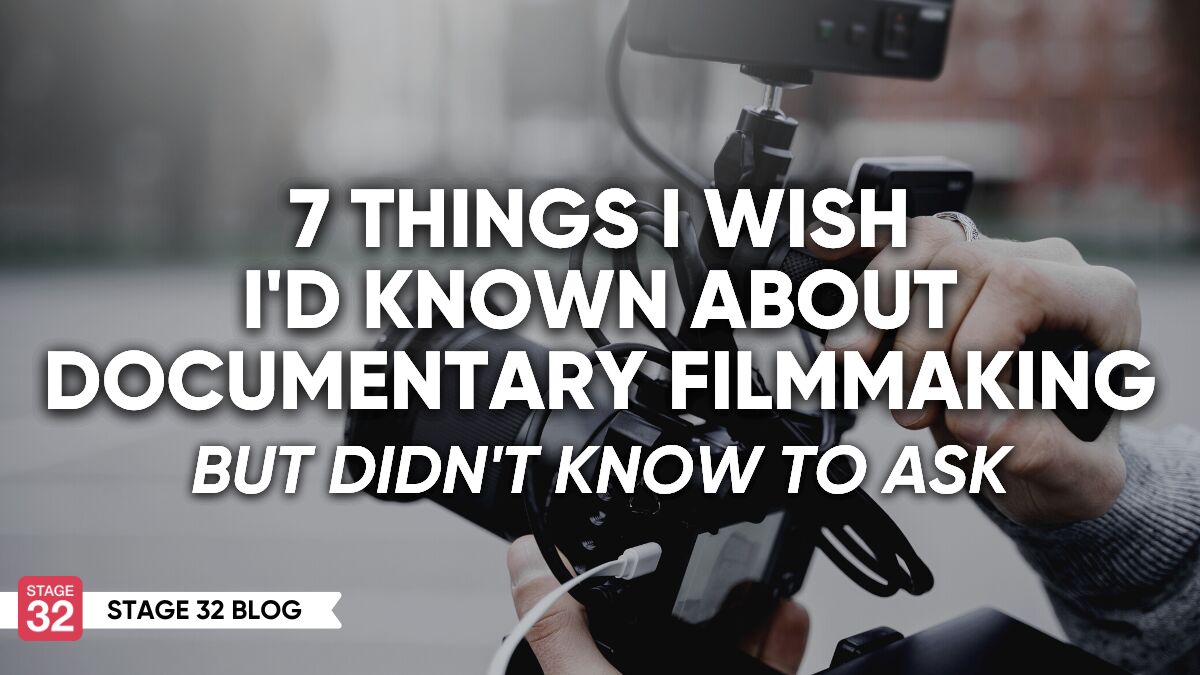7 Things I Wish I'd Know About Documentary Filmmaking But Didn't Know To Ask
If you’re a first-time documentary filmmaker, as I was when I started making my “Land of the Free” films, you may not be aware of some of the expenses and challenges you are going to face in producing, polishing, and distributing your film. After years of trials, tribulations, and successes, here are the top lessons I wish I'd known (or at least thought to ask)...
1. The Script
Everything in movie and stage production lives or dies by its script.
What’s the story you want to tell?
What is shocking about it?
What are the challenges relating to this issue?
What are the solutions?
Documentary making is storytelling just as much as any other art form is, so map out your story first. Your opening must be intriguing – compelling. Your closing must be something everyone will walk away remembering – it should be a killer last line and/or an incredible last minute of footage with moving and memorable music. In many ways, the last moments of your film are the most important. The first impression will (or should) draw your audience in, but the last impression is what will be, well, lasting.
2. The Talent and Locations
Okay, you have your story. Now what?
Now you need to work out who your talent is and where they are. Is this a story that can be shot all in your hometown, or is interstate and/or international travel going to be involved? Do you have a way of reaching the talent you need to film? Or do you know someone who does? What’s their availability like? Will they work pro bono or require a fee? Do you need a Voice Over artist or Narrator to fill in some of the gaps? Are you filming in any locale/s where you need to obtain a license first?
This phase maps out your shooting schedule and starts to build the basis for your budget.

3. The Budget
It’s a dirty word, but it has to be done. Have you thought of everything you need to include?
HINT: no, you haven’t!
You’ve probably thought about talent fees (if any) and locale licenses (if any). You’ve probably thought about the camera, sound, and light (well, I hope you have). If you’re shooting in more than one locale, will the film crew travel with you (meaning travel costs), or will you have to pick up local crews in situ (meaning additional crew costs)? Are there any particular idiosyncrasies of your film shoot that could impact your costs? Is it weather dependent? Are you trying to shoot wildlife that may not always turn up on cue? You need to make allowances for such things. If you’re traveling, you also need to consider delays in flights, lost luggage, equipment damage, and people getting sick or injured.
All these things happen, so you need adequate insurance and backup plans. But that’s not all. More budget items are covered in points 5 and 6 below.
4. Financing
So now you have a budget. Where are you going to get the money?
There are endless possibilities. Perhaps one or more of these would work for you. Sponsors with sympathy towards the subject? Film grants from the many government bodies and NGOs who support projects like this? Private donors? Private investors? Crowdfunding? Fundraising events? Equity shares in the finished product.
However, before you approach any of these, you need a pitch document, or “the deck” or Executive Summary document. This needs to cover what your project is about, who is in it, why it is important, how it is different, what your marketing, film competition, and distribution plans are, and what financial returns can reasonably be expected if this is commercial.
Very few documentaries are really commercially viable. There are exceptions, of course, but most are passion projects. If your project is a passion project, you must get passionate about finding other passionate people with deep pockets. Two things are going to motivate people or organizations to put money into your projects – either financial returns or a shared passion for the subject. Perhaps your film stands a real chance of bringing about social change. If so, you need a follow-through plan of action and that needs to become part of your deck or Executive Summary.

5. Post-Production
Right then. You’ve got a story, talent, locales, film crew, and funding. Wow! You’re awesome! Take three gold stars out of petty cash!! Have you thought about post-production? Well, of course, you have. But have you thought about who’s going to do it? What experience and expertise do they have? What is their availability like? Will they do it? And, oh yes, what are they going to cost? There’s music. Are you having it composed? Licensing? Using royalty-free music? What’s involved in your chosen option, and what’s the cost? Then there’s the final sound and color mix – two separate art forms in their own rights. There are the opening titles and closing credits… and be sure you don’t forget anyone or misspell a name!! Oh, the horror!! Are you going to screen a beta version with a test group to check there aren’t any wrinkles you’ve overlooked before you let your baby loose into the big, wide world? So many things to think about, aren’t there?
6. Distribution Plans
We have arrived! It’s in the can. It’s filmed, edited, and polished. The music and titles have been added. Your test audience all believe it’s Oscar-worthy. You’re feeling darn proud of yourself, and so you should be. Now what? Are you going to enter it at film festivals? If so, which ones are suitable based on your genre and length of film? What are their submission deadlines? And what are their entry costs (there’s another budget item)? Do you want to attend film festivals where your submission is selected? This will give you a chance to move and mingle, schmooze and pitch with people who already have a penchant for your type of film. But guess what – this is another cost/budget item. Or perhaps film festivals aren’t for you. They don’t suit everyone. In which case, you need to be pitching for Network sales and/or streaming deals. Who do you go to? Who are the best contacts? What’s the best way to reach them? Who is actively looking for content like yours? Educate yourself about what they pay to ensure you are not ripped off.
7. Social Media and Your Marketing
Social media. No one is going to watch your film if they don’t know about it. Once it’s out there, you need to tell the world about it… and you need to go on doing it because people’s attention span is short. Folks are easily distracted by the next shiny bauble that comes along so you need to keep reminding everyone that yours is shinier and a more important bauble than anyone else’s.
I hope this has helped someone out there, and as always, I’ll be happy to answer questions.
Thank you Stage32 for giving me this platform. To everyone out there:
Never give up
Never give in
Your art is power
So says Lynn :)
Let's hear your thoughts in the comments below!
Got an idea for a post? Or have you collaborated with Stage 32 members to create a project? We'd love to hear about it. Email Emily at blog@stage32.com, and let's get your post published!
Please help support your fellow Stage 32ers by sharing this on social. Check out the social media buttons at the top to share on Instagram @stage32 Twitter @stage32 Facebook @stage32 and LinkedIn @stage-32
| How to Use Your Audience’s Imagination to Tell Your Story |
| 4 Ways To Calculate and Track Your Artistic Progress |
Search Stage 32 Blog
There are now 4037 blog posts for you to enjoy. Search them all by tags below.
Acting, Advice, Cinematography, Coffee & Content, Composing, Contests, Distribution, Featured, Filmmaking, Financing, Inspirational, Networking, Producing, Screenwriting, Success Stories, Tips, Trending,Relevant Tags
Recommended Articles

November Write Club Week 4: The Art of the Pitch- What Managers & Execs Actually Want to Hear

November Write Club Week #3: How To Make A Strong First Impression When Meeting Execs, Producers, & Reps

Insider Intel: The Studio War & The Rise of Indies

Coffee & Content: The Genius of Weapons and How to Know When Your Script Is Ready

Green Lights and Grey Areas: Expanding Creative Collaboration in Publishing

Don't Let the Momentum of November Write Club Die: How to Stay Active Into 2026 & Beyond!

Find Your Footing on Stage 32: Join Our December Community Open House

Coffee & Content: Why Your Next Step Matters More Than the Perfect Step

Coffee & Content: Reinvent the Story, Reinvent the Industry






